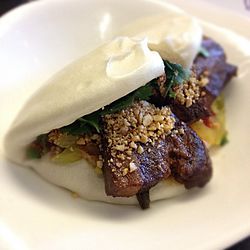Gua bao facts for kids

A traditional gua bao
|
|
| Course | Snack, delicacy, main dish, side dish |
|---|---|
| Place of origin | Fujian, China |
| Serving temperature | Hot |
| Main ingredients | Lotus leaf bread, stewed meat, condiments |
| Ingredients generally used | Red-cooked pork belly, pickled mustard, coriander, ground peanuts |
| Variations | Fried chicken, fish, eggs, stewed beef, lettuce |
Gua bao (Chinese: 割包 or 刈包; pinyin: guàbāo; Pe̍h-ōe-jī: koah-pau; literally "cut bread"), also called pork belly buns, is a yummy steamed bun sandwich. It comes from Fujian cuisine in China. People often call it "bao" or "bao bun," but its full name is Gua bao.
This tasty snack is super popular in Taiwan. You can find it at night markets and restaurants. It's also a favorite street food in places like Singapore, Malaysia, Philippines, and Nagasaki Chinatown in Japan.
A Gua bao has a slice of stewed meat and other toppings. These are placed inside a soft, flat steamed bread. This bread is known as lotus leaf bread or hé yè bǐng. The bread is usually about 6–8 cm (2.4–3.1 inches) wide. It's shaped like a half-circle with a fold in the middle. When you open it, it looks like it's been sliced, ready to hold its delicious filling.
The classic filling for Gua bao is a slice of red-cooked pork belly. It's often topped with stir-fried suan cai (pickled mustard greens), fresh coriander, and crushed peanuts.
History of Gua Bao
Gua bao has a long and interesting history. It started in China and spread across Asia. Later, it became famous in Western countries too.
Gua Bao in Asia
The Gua bao first came from the coastal areas of Fujian province in China. Some say it started in the cities of Quanzhou or Fuzhou. In Quanzhou, it's sometimes called rou jia bao (meat between buns). It's also known as hu yao shi (tiger bites lion).
In Hui'an County, people eat these pork belly buns for special events. For example, they eat them to celebrate when a daughter gets married. In Jinjiang, Fujian, there's a similar dish. It's called hu yao cao (tiger bites grass). This version is vegetarian. It uses a peanut paste instead of pork. The bread is baked in a clay oven.
In Taiwan, Gua bao became popular during Japanese rule. At that time, pork and flour were expensive. So, this dish became a special treat. By the 1970s, it was a common street food. Today, it's a famous Taiwanese snack. It's often served with Four-Herbal Soup at night markets.
Fuzhounese immigrants are thought to have brought Gua bao to Taiwan. In some parts of Taiwan, people call it hó͘-kā-ti (Chinese: 虎咬豬; literally "tiger bites pig"). This is because the bun looks like a mouth biting the filling.
An old vendor once said that the original dish was chopped ingredients in a bowl. It was hard to eat on the go. So, the bun was created to make it easier to carry and enjoy.
In Singapore and Malaysia, Gua bao is popular with the Hokkien people. They call it kong bak pau (扣肉包 khòng-bah-pau).
In the Philippines, you can find it in Chinese Filipino restaurants. There, it's usually called cuapao (Filipino/Tagalog: kuwapaw).
In Hong Kong, they are known as cha bao (叉包). This means "fork buns." They often have a toothpick or skewer to hold the filling in place.
In Japan, they are called kakuni manju (角煮饅頭). They are sold as a Chinese snack. They are a special food in Nagasaki Chinatown. This is because many Fuzhounese immigrants settled there long ago. Nagasaki and Fuzhou became sister cities in 1980. This shows their strong historical connection.
Gua Bao in the West
Gua bao became well-known in Western countries in the early 2000s. Chef David Chang helped make them famous. He served them at his Momofuku restaurants starting around 2004. He says he didn't know Gua bao already existed. His recipe came from wanting to use leftover pork from his ramen. He was inspired by how Peking duck was served on lotus leaf bread in Beijing. He called his dish pork belly buns.
The name "gua bao" became popular thanks to chef Eddie Huang. He opened his BaoHaus restaurant around 2009. Since then, many restaurants have started serving Gua bao. But they sometimes just call it "bao" or "bao bun."
In the United States, New York City has many Fuzhounese Americans. Gua bao is a popular dish there. You can find it alongside other Fuzhou foods like Fuzhou fish balls.
In the United Kingdom, Erchen Chang, Wai Ting, and Shing Tat Chung opened BAO in London. This helped make the snack even more popular in the West. Gua bao are often called hirata buns in the UK. This name comes from Masashi Hirata, a chef at Ippudo in New York. Many ramen restaurants started selling Gua bao. This was due to Momofuku's influence and high customer demand. Customers sometimes thought they were a standard ramen dish.
Today, there are many new types of "gua bao." Some have different fillings, like kimchi or karaage. These are not traditional Gua bao. In China, they would just be called different kinds of lotus leaf bun sandwiches.

